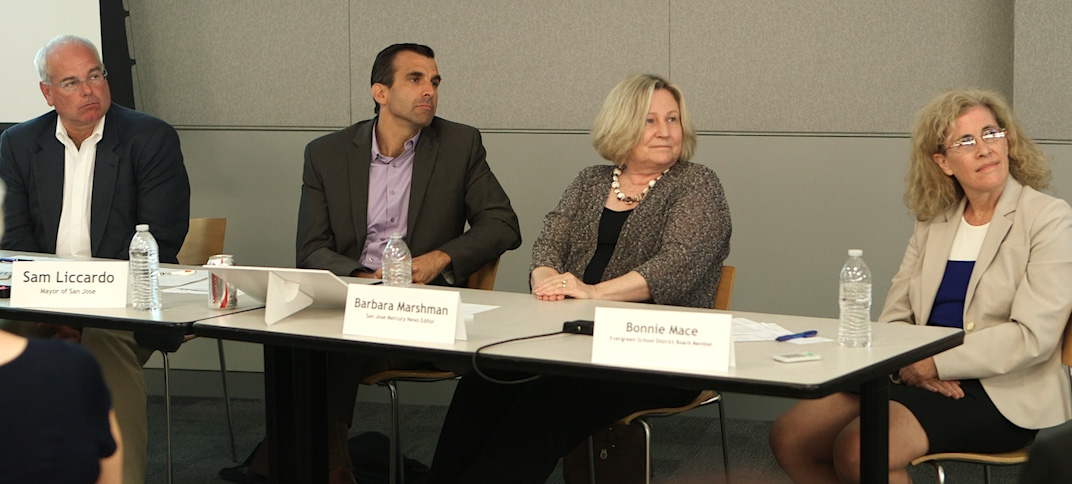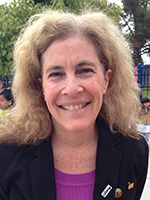
Lenny Mendonca, co-chair of CA Fwd’s leadership council (left), Sam Liccardo, Mayor of San Jose, Barbara Marshman, San Jose Mercury News editor and Bonnie Mace at Money, Schools, Jobs and You – A Bipartisan Conversation San Jose. (Photo credit: Angel Cardenas)

Editor’s Note. Bonnie Mace is the Executive Director of the Santa Clara County School Boards Association who participated in California Forward’s Bipartisan Conversation at San Jose State University on Wednesday night (August 19th). She also serves as member of the Evergreen School Board and formerly worked for California Forward.
A wave of transformational innovation is under way in California’s education system. As bipartisan leaders, we need to harness this wave towards benefitting every child in the state.
Here are the five most important actions that we can take to ensure that the education system is equitable and leads to success for every student.
- Focus on the “whole child” from cradle to career with a long-term growth mindset and an equity lens. The definition of what it means to be a “student” is expanding. Early learning research shows us that education does not begin in kindergarten, but learning begins from birth. Nor does the education of a student end with high school graduation; rather it must be inextricably linked to career opportunities and higher education. Educational approaches must address the needs of the “whole student”, including cognitive, linguistic, social, emotional, and cultural dimensions. Assessment should focus on a “growth mindset” in which students believe that they can improve over time. Above all, new assessment measures must reflect the “whole student” rather than focusing only on a single measure of achievement in testing. In the new system, Equity should and must continue to be a critical issue, with the ongoing goal of narrowing of the achievement gap for all students.
- Personalize and expand learning opportunities. The educational system of the future will be personalized, which means that learning opportunities will cater to the student’s individual needs. There is a difference between blended learning and personalized learning. The former refers to a mix of online technology instruction in addition to traditional classroom teaching; the latter refers to instruction in which students progressively learn based on their own starting point. New technology apps make this personalized learning possible. Additionally, the timeframe of learning is gradually expanding, and the school day and the school year are lengthening. Broadband initiatives seeking to remedy the digital divide such as the CDE’s No Child Left Offline are a key part of this transformation, ensuring that every student has access to the internet. As personalized and extended learning become more important, rapid, ongoing formative assessment becomes increasingly critical. Common Core Standards are a first step in this process of deeper personalized learning, but there will be other steps along the way.
- Align the entire regional educational system vertically and horizontally and ensure accountability at all levels. The educational system is expanding to include all the structures that impact the student’s development from cradle to career. These formative structures include: family, community, school, school district, county and city government, nonprofit service providers, community colleges and four-year colleges and universities, and the state and federal government. This is a complex system with many moving parts, and the most important action we can take to harness innovation for the benefit of every student is to align the entire system vertically (ie. the P-16 pipeline) and horizontally (ie. geographically) to ensure that regional educational systems succeed. Accountability and metrics at all levels are essential, and data-sharing management, research-based metrics, and a larger conversation about student privacy are all critical.
- Engage everyone in a common mission and leverage resources through public-private partnerships. Innovative thinkers are expanding the way we define “stakeholder engagement”. The LCAP is one piece of this puzzle, as it requires expanded and meaningful parent and community engagement and more local control and accountability. The important conversations at this point need to be around a definition of “engagement”; it needs to be more than just checking a box. Live streaming of public meetings and more open government must be part of this process. Public-private partnerships become more important as a way to leverage tax dollars and ensure that there is adequate funding of the entire educational system. Business leaders need to be seen as integral part of the education system, as we develop new connections between high school, college and the workforce. The key to successful engagement is to have respected nonpartisan champions in the business and educational community.
- Build networks of human capital across the entire system and reward innovative teachers and schools. Transformational change is never easy. The most important action leaders can take is to build networks of trust and human capital across the system. Without it progress will be slow and unsteady. Bipartisan organizations like CA Fwd will be an important part of this capacity-building process, as they bring leaders together to form relations of trust. Above all, we should reward innovative people and schools that have research-based evidence of success for every student.
Transformational change in the California education system is occurring faster than we think. Leaders need to look at the entire system and engage in design thinking, rather than just trying to fix pieces of the puzzle. Zooming in with a narrow focus will prove short-sighted in the long run, but zooming out with a broader systems focus will create the conditions for success for every student.

